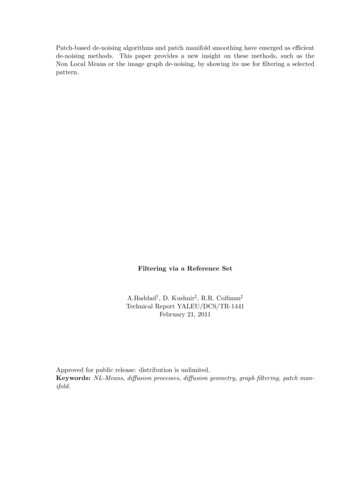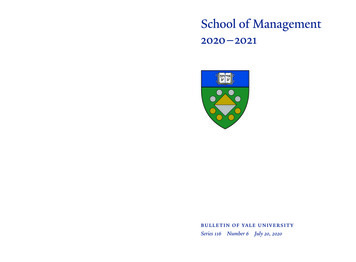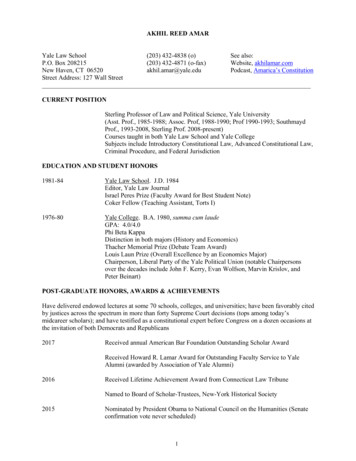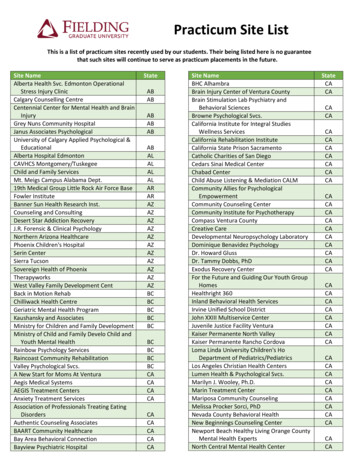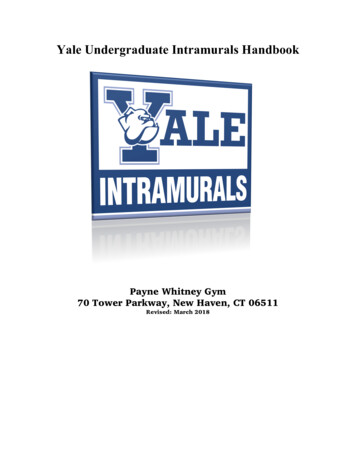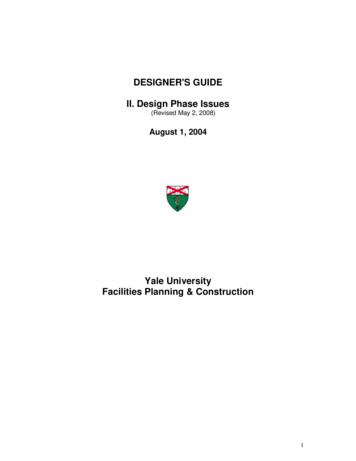
Transcription
Physics 200Problem Set 6Solution1. (i) What is the moment of inertia ICM of a propeller with three blades (treated as rods) of massm, length L, at 120 relative to each other? (ii) If a torque τ acts on this how long will it take toreach an angular velocity ω? (iii) How many revolutions will it have made before reaching this ω?(iv) Get the numerical answers if L 1.25 m, m 12 kg, τ 3000 N · m, ω 2000 rad/s.Answer:(i) We know (if not, look on p. 296) that the moment of inertia of a single rod rotating aroundits end is 31 mL2 . It’s not hard to convince oneself that if there are three of them rotatingaround the same axis and in the same plane, the moment of inertia is just three times this,ICM mL2 .(ii) Since ω αt and τ ICM α,t mL2 ωICM ω .ττ(iii) From our knowledge of constant acceleration problems,ω 2 2αθ θ ICM ω 2mL2 ω 2ω2 .2α2τ2τThe number of revolutions it made isN mL2 ω 2θ .2π4πτ(iv)ICM (12 kg)(1.25 m)2 19 kg · m2 ,(12 kg)(1.25 m)2 (2000 s 1 ) 13 s,2(3000 N · m)(12 kg)(1.25 m)2 (2000 s 1 )2N 2000.4π(3000 N · m)t 2. Consider I for a rectangle of sides a (along the y-axis) and b (along the x-axis) about the twosymmetry axes. (Rotate the rectangle about one of these axes and think of it as composed of1M a2 . Going back to the very definition ofrods.) Show that about the axis parallel to x, I 12I, show that if this rectangle is spun around an axis through its CM and perpendicular to its area1M (a2 b2 ).the moment of inertia will be I 12Answer: To find Ix , the moment of inertia about the symmetry axis parallel to the x-axis, wethink of dividing the rectangle into many thin rods:1
yaxbSince each “rod” has length a, it should be obvious that the sum of these contributions is simply1212 M a , i.e., the same as if there was one rod of mass M rotating around the axis, but let’s be moreexplicit. If we divide up the rectangle into n rods (where n is large so they really are rods, thoughin the end it doesn’t matter) so that each rod has mass M/n, then with each rod contributing1 M12212 ( n )a and there being n rods, we get Ix 12 M a as expected. The same logic of course appliesto the symmetry axis parallel to the y-axis.From the definition of the moment of inertia,I Xri2 mi .iNotice from the picture thatri22 (xi b/2) (yi x/2)2 , so we can writey(xi,yi)ar(b/2,a/2)xb¶2X³Xµa 21b mi yi mi Iy Ix Ix Iy M (a2 b2 ).I xi 2212iiIt’s easy to see that this kind of argument will work for any flat object, as long as you choose youraxes to be perpendicular to each other.3. A 4.8 kg block is resting at the top of a 30 slope of height 1 m. It is attached to a cylindrical pulleyof mass 1.7 kg and radius 8 cm by a massless string that unwinds as the block slides downhill. Ifthe acceleration of the block is 1.9 m/s2 what is µk ? Find the velocity at the bottom of the slopeusing forces and torques. Repeat using energy ideas. See Fig. 1.Answer: Numbers are cumbersome, so let’s start by letting m be the mass of the block, θ theangle, h the height, M the mass of the pulley, R its radius, and a the acceleration felt by the block.As usual, we decompose the forces on the block into those that are parallel to the slope and thosethat are perpendicular to the slope. In the perpendicular direction, the component of gravity inthis direction mg cos θ balances the normal force, so N mg cos θ. In the parallel direction, wehavemg sin θ T fk ma2
Figure 1: The block started at height h.(we take downhill to be positive), where the kinetic friction term is given by fk µk N µk mg cos θ. We now need the tension T , which we find as follows. The acceleration a that theblock feels is converted to angular acceleration in the pulley, where a Rα. But we also knowthat τ RT Iα where I 21 M R2 is the moment of inertia of the pulley. ThereforeT Ia1Iα 2 M a,RR2and plugging into the above equation we getµfk mg sin θ T ma mg sin θ ¶M m a.2Thenmg sin θ (M/2 m)afk .mg cos θmg cos θBefore plugging in the numbers, note that we can make our lives just a little easier by rearranginga little bit:µk µk sin 30 [1 ((1.7 kg)/2(4.8 kg))(1.9 m/s2 )/(9.81 m/s2 )sin θ (1 M/2m)a/g 0.31.cos θcos 30 Since the block travels a distance d h/ sin θ, the velocity at the bottom of the slope, startingfrom rest at the top, isrr2ah2(1.9 m/s2 )(1 m)2ah2 v 2.8 m/s.v 2ad sin θsin θsin 30 The energy method is somewhat more involved. At the top, the energy of the block is purelypotential energy, mgh. At the bottom, the potential energy is zero, the kinetic energy of the blockis T 21 mv 2 , and the rotational kinetic energy of the pulley isµ¶³ 11 21 1v 22Iω MR M v2 .22 2R4Some energy was also lost to friction, so we must take that into account. The work done by frictionisµk mghh .fk d µk mg cos θ ·sin θtan θWe can finally use the conservation of energy in the formmgh 11µk mghmv 2 M v 2 ,24tan θ3
which meanssv s2gh(1 µk / tan θ) 1 M/2m2(9.81 m/s2 )(1 m)(1 0.31/ tan 30 ) 2.8 m/s.1 (1.7 kg)/2(4.8 kg)As one would expect, the two answers agree.4. Argue that that A · (A B) 0. In three dimensions find the expression of A B in terms ofvector components and î, ĵ, and k̂.Answer: Since A B is always perpendicular to both A and B, the dot product with A must bezero. For the second part, we use the basic relationsî î ĵ ĵ k̂ k̂ 0,î ĵ ĵ î k̂,ĵ k̂ k̂ ĵ î,k̂ î î k̂ ĵ.Thus when we expand the cross product, we can immediately drop any term that contains thesame unit vector twice:A B (Ax î Ay ĵ Az k̂) (Bx î By ĵ Bz k̂) Ax By (î ĵ) Ax Bz (î k̂) Ay Bx (ĵ î) Ay Bz (ĵ k̂) Az Bx (k̂ î) Az By (k̂ ĵ) (Ay Bz Az By )î (Az Bx Ax Bz )ĵ (Ax By Ay Bx )k̂.We can also check thatA · (A B) Ax (Ay Bz Az By ) Ay (Az Bx Ax Bz ) Az (Ax By Ay Bx ) 0,as we argued.5. A disk of radius R and mass M is spinning at an angular velocity ω0 rad/s. A non-rotatingconcentric disk of mass m and radius r drops on it from a negligible height and the two rotatetogether. (See Fig. 2). Find the final ω and fraction of initial kinetic energy left.m, rM, RFigure 2: The upper disk, initially at rest, falls withnegligible speed on the lower one which is spinning.Their centers coincide.Answer: Let IM 21 M R2 be the moment of inertia of the disk of radius R, and Im 21 mr2 themoment of inertia of the other disk. Initially the angular momentum of the system is IM ω0 , andwhen the two disks are rotating together the angular momentum is (IM Im )ω. Since angularmomentum is conserved,IM ω0 (IM Im )ω ω 4ω0IM ω0 .IM Im1 mr2 /M R2
Before the second disk is added, the rotational kinetic energy of the system is 21 IM ω02 , and afterwardthe kinetic energy is 21 (IM Im )ω 2 . Therefore the fraction of the initial kinetic energy left is122 (IM Im )ω122 IM ω0µIM Im IMωω0¶2IM Im IMµIMIM Im¶2 IM1 .IM Im1 mr2 /M R2Evidently the kinetic energy is conserved only if the initially rotating disk has infinite moment ofinertia, or if the second disk has no moment of inertia.6. A gyro consists of a solid disk of radius R mounted at one end of a shaft of zero mass and lengthl, the other end of which is on a pivot. The disk spins at ω rad/s and the gyro precesses at ωprad/s. What is l in terms of ωp , ω, g and R? Give a number for l when R 6 m, ωp 2.6 rad/s,and the disc is spinning at 450 rpm?Answer: Note that the mass of the disk is not given in this problem, so we’ll say the mass is Mand see why it doesn’t matter what the mass is. The magnitude of the angular momentum isL Iω 21 M R2 ω. Since gravity acts at distance l from the pivot, the torque produced by theforce τ M gl, and so the equation for a gyroscope tells usωp M glτ2gl 2 .2LM R ω/2R ωAs we hoped, the mass has canceled from the equation. Solving for the length of the shaft givesl 450 rpm is450 rpm ·sol R2 ωωp.2g2π rad 1 min 47 rad/s,1 rev 60 s(6 m)2 (47 s 1 )(2.6 s 1 ) 220 m,2(9.81 m/s2 )which is quite a large number.7. Two beads of mass m are free to slide on a rod of length l and mass M as in Fig. 3. Initially thebeads are at the center and the rod is spinning freely (with no external torque) at ω0 rad/s abouta vertical axis through its center. Slowly the beads move radially out (at negligible velocity). (i)Find ω(r), the angular velocity when the beads are r m from the center. (ii) What is ω when theyjust fly tangentially off the rod? Argue that ω does not change hereafter. (Hint: Using the formulaL r p for the angular momentum of beads show that their L’s do not change even though r’sdo. Also are there any torques on the spinning rod after the beads detach?) (iii) Why was theforce of friction between beads and rod unimportant in the preceding discussion?Answer:(i) Initially the moment of inertia of the system is due only to the rod, because r 0 for1M l2 , and the angular momentum is L I0 ω0 . If the beads are athe beads. So I0 12distance r from the center, each one contributes mr2 to the system’s moment of inertia, soI(r) I0 2mr2 . Since angular momentum is conserved, I0 ω0 Iω, orω(r) I0 ω0ω0I0 ω0ω0 . 22II0 2mr1 2mr /I01 24mr2 /M l25
Figure 3: The point-like beads can slide along the rodwhich is spinning around a vertical axis through itsCM. The beads start out at the center of the rod.(ii) The beads fly off the rod when r l/2, so at this timeµ ¶ω0l ω.21 6m/MOnce the beads fly off the rod, they continue moving in a straight line at constant velocity,so p is a constant. For each bead the angular momentum L r p points out of the pagein the figure and has magnitude r p sin θ. Since p stays constant, the angular momentumdepends entirely on the quantity r sin θ, and looking at the figure below where the positionof one of the beads is indicated at two different times after flying off the rod, we see that r1 sin α r2 sin β l/2. The same logic applies to the other bead, so that L for the beadsdoes not change once they leave the rod. This in turn means that the remaining angularmomentum, the angular momentum possessed by the rod, does not change either, and sincethe moment of inertia of the rod stays put its angular velocity ω must remain constant, too.ml/2l/2r1pαr2mβ(iii) While the beads are on the rod, the force of friction F acts in the same direction as the positionr, so the torques are r F 0. But it is torques, and not forces, that affect rotational motion,so F can have no effect. This applies to when the beads are on the rod; once they leave therod, there is of course no friction.8. A sphere of radius R is supported by a rope attached to a wall as shown in Fig. 4. The rope makesan angle θ with respect to the wall. The point where the rope is attached to the ball is such thatif the line of the rope is extended it crosses the horizontal line through the center of the ball ata distance 3R/2 from the wall. Show that the minimum µs between wall and ball for this to be6
possible is µs 21 cot θ. Evaluate this for θ 30 . Hint: Find the right place to take torques. Theusual suspects will not do.θx3R/2Figure 4: The rope is attached to the wall at one endand the ball at the other. If extrapolated, the line ofthe rope crosses the horizontal line going through thecenter at a distance 3R/2 from the wall.Answer: We need to balance both the forces and the torques, and it is the latter that is trickyhere. So consider the figur
x y a b Since each \rod" has length a, it should be obvious that the sum of these contributions is simply 1 12 Ma 2, i.e., the same as if there was one rod of mass rotating around the axis, but let's be more explicit. If we divide up the rectangle into n rods (where n is large so they really are rods, though in the end it doesn't matter) so that each rod has mass M n, then with each rod .

